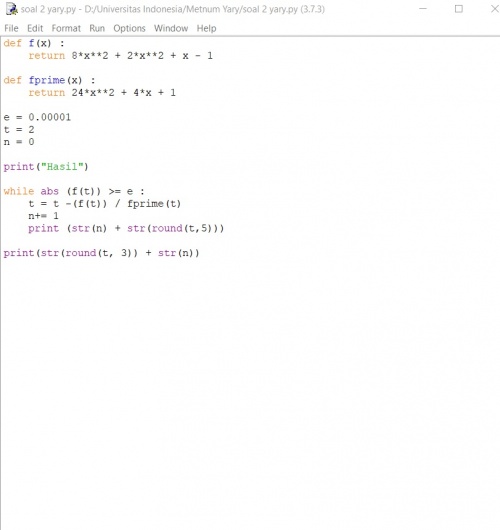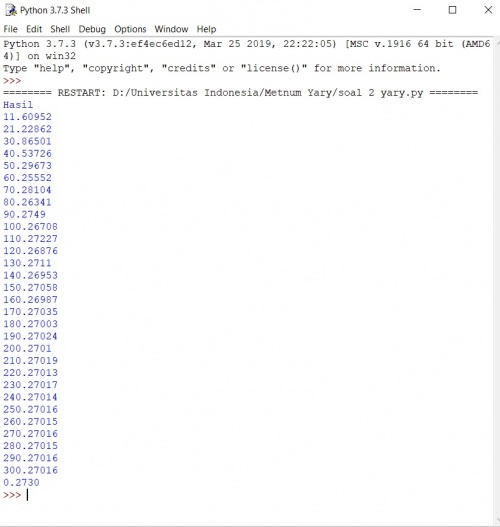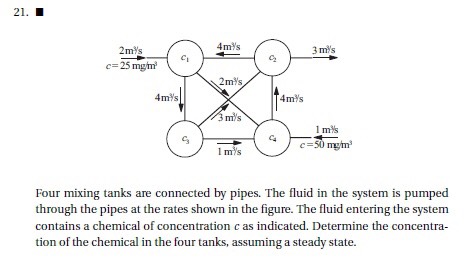Difference between revisions of "Yarynara Sebrio. S"
(→UTS) |
(→UTS) |
||
| Line 19: | Line 19: | ||
== '''Tugas Metode Numerik''' == | == '''Tugas Metode Numerik''' == | ||
==UTS== | ==UTS== | ||
| + | 1.A | ||
| + | import numpy as np | ||
| + | class GEPP(): | ||
| + | def __init__(self, A, b, doPricing=True): | ||
| + | #super(GEPP, self).__init__() | ||
| + | self.A = A # input: A is an n x n numpy matrix | ||
| + | self.b = b # b is an n x 1 numpy array | ||
| + | self.doPricing = doPricing | ||
| + | |||
| + | self.n = None # n is the length of A | ||
| + | self.x = None # x is the solution of Ax=b | ||
| + | |||
| + | self._validate_input() # method that validates input | ||
| + | self._elimination() # method that conducts elimination | ||
| + | self._backsub() # method that conducts back-substitution | ||
| + | |||
| + | def _validate_input(self): | ||
| + | self.n = len(self.A) | ||
| + | if self.b.size != self.n: | ||
| + | raise ValueError("Invalid argument: incompatible sizes between" + | ||
| + | "A & b.", self.b.size, self.n) | ||
| + | |||
| + | def _elimination(self): | ||
| + | """ | ||
| + | k represents the current pivot row. Since GE traverses the matrix in the | ||
| + | upper right triangle, we also use k for indicating the k-th diagonal | ||
| + | column index. | ||
| + | :return | ||
| + | """ | ||
| + | # Elimination | ||
| + | for k in range(self.n - 1): | ||
| + | if self.doPricing: | ||
| + | # Pivot | ||
| + | maxindex = abs(self.A[k:, k]).argmax() + k | ||
| + | if self.A[maxindex, k] == 0: | ||
| + | raise ValueError("Matrix is singular.") | ||
| + | # Swap | ||
| + | if maxindex != k: | ||
| + | self.Ak, maxindex = self.Amaxindex, k | ||
| + | self.bk, maxindex = self.bmaxindex, k | ||
| + | else: | ||
| + | if self.A[k, k] == 0: | ||
| + | raise ValueError("Pivot element is zero. Try setting doPricing to True.") | ||
| + | # Eliminate | ||
| + | for row in range(k + 1, self.n): | ||
| + | multiplier = self.A[row, k] / self.A[k, k] | ||
| + | self.A[row, k:] = self.A[row, k:] - multiplier * self.A[k, k:] | ||
| + | self.b[row] = self.b[row] - multiplier * self.b[k] | ||
| + | |||
| + | def _backsub(self): | ||
| + | # Back Substitution | ||
| + | self.x = np.zeros(self.n) | ||
| + | for k in range(self.n - 1, -1, -1): | ||
| + | self.x[k] = (self.b[k] - np.dot(self.A[k, k + 1:], self.x[k + 1:])) / self.A[k, k] | ||
| + | |||
| + | |||
| + | def main(): | ||
| + | A = np.array([[1., 0., 0., 0.], | ||
| + | [-1., 1., 0., 0.], | ||
| + | [0., 0., -1., 1.], | ||
| + | [0., 0., 0., 1.]]) | ||
| + | b = np.array([[50.], | ||
| + | [20.], | ||
| + | [5.], | ||
| + | [10.]]) | ||
| + | GaussElimPiv = GEPP(np.copy(A), np.copy(b), doPricing=False) | ||
| + | print(GaussElimPiv.x) | ||
| + | print(GaussElimPiv.A) | ||
| + | print(GaussElimPiv.b) | ||
| + | GaussElimPiv = GEPP(A, b) | ||
| + | print(GaussElimPiv.x) | ||
| + | if __name__ == "__main__": | ||
| + | main() | ||
| + | |||
| + | |||
1.B | 1.B | ||
#masukan plugin numpy | #masukan plugin numpy | ||
Revision as of 21:28, 27 October 2019
Biografi
Nama : Yarynara Sebrio Suharyadi
TTL : Jakarta,23 September 1999
NPM : 1706070816
Jurusan : Teknik Mesin Paralel Universitas Indonesia
Hobi : Bermain Tenis lapangan
Di bagian pemograman python ini saya mempelajari cara mengerjakan operasi matematika yang sering digunakan untuk membuat simulasi di berbagai sistem seperti fisika,kimia,biologi , cara menyelesaikan matematika tersebut cukup sulit diperoleh karena persamaan disamping yang tidak efisien
Tugas Metode Numerik
UTS
1.A import numpy as np class GEPP():
def __init__(self, A, b, doPricing=True):
#super(GEPP, self).__init__()
self.A = A # input: A is an n x n numpy matrix
self.b = b # b is an n x 1 numpy array
self.doPricing = doPricing
self.n = None # n is the length of A
self.x = None # x is the solution of Ax=b
self._validate_input() # method that validates input
self._elimination() # method that conducts elimination
self._backsub() # method that conducts back-substitution
def _validate_input(self):
self.n = len(self.A)
if self.b.size != self.n:
raise ValueError("Invalid argument: incompatible sizes between" +
"A & b.", self.b.size, self.n)
def _elimination(self):
"""
k represents the current pivot row. Since GE traverses the matrix in the
upper right triangle, we also use k for indicating the k-th diagonal
column index.
:return
"""
# Elimination
for k in range(self.n - 1):
if self.doPricing:
# Pivot
maxindex = abs(self.A[k:, k]).argmax() + k
if self.A[maxindex, k] == 0:
raise ValueError("Matrix is singular.")
# Swap
if maxindex != k:
self.Ak, maxindex = self.Amaxindex, k
self.bk, maxindex = self.bmaxindex, k
else:
if self.A[k, k] == 0:
raise ValueError("Pivot element is zero. Try setting doPricing to True.")
# Eliminate
for row in range(k + 1, self.n):
multiplier = self.A[row, k] / self.A[k, k]
self.A[row, k:] = self.A[row, k:] - multiplier * self.A[k, k:]
self.b[row] = self.b[row] - multiplier * self.b[k]
def _backsub(self):
# Back Substitution
self.x = np.zeros(self.n)
for k in range(self.n - 1, -1, -1):
self.x[k] = (self.b[k] - np.dot(self.A[k, k + 1:], self.x[k + 1:])) / self.A[k, k]
def main():
A = np.array([[1., 0., 0., 0.],
[-1., 1., 0., 0.],
[0., 0., -1., 1.],
[0., 0., 0., 1.]])
b = np.array([[50.],
[20.],
[5.],
[10.]])
GaussElimPiv = GEPP(np.copy(A), np.copy(b), doPricing=False)
print(GaussElimPiv.x)
print(GaussElimPiv.A)
print(GaussElimPiv.b)
GaussElimPiv = GEPP(A, b)
print(GaussElimPiv.x)
if __name__ == "__main__":
main()
1.B
- masukan plugin numpy
import numpy as np
def diff_y (x,y):
fungsi = x**2 - 4*y
return (fungsi)
#definisikan syarat perhitungan
x=0
y=1
h=0.7
j=5
step_size = 0.5
step_size = -np.arange (0,0.5,h)
for t in step_size:
k1 = diff_y (x,y)
k2 = diff_y ((x+0.5*h),(y+0.05*k1*h))
#simulasi hasil
w1 = y + 1/3*(k1+2*k2)
#cek kecepatan pada saat 0,7 detik
print ('maka x(0.7) sama dengan', w1)
Quiz
Quiz nomor 1.
import numpy as np
class GEPP():
def __init__(self, A, b, doPricing=True):
#super(GEPP, self).__init__()
self.A = A # input: A is an n x n numpy matrix
self.b = b # b is an n x 1 numpy array
self.doPricing = doPricing
self.n = None # n is the length of A
self.x = None # x is the solution of Ax=b
self._validate_input() # method that validates input
self._elimination() # method that conducts elimination
self._backsub() # method that conducts back-substitution
def _validate_input(self):
self.n = len(self.A)
if self.b.size != self.n:
raise ValueError("Invalid argument: incompatible sizes between" +
"A & b.", self.b.size, self.n)
def _elimination(self):
# Elimination
for k in range(self.n - 1):
if self.doPricing:
# Pivot
maxindex = abs(self.A[k:, k]).argmax() + k
if self.A[maxindex, k] == 0:
raise ValueError("Matrix is singular.")
# Swap
if maxindex != k:
self.Ak, maxindex = self.Amaxindex, k
self.bk, maxindex = self.bmaxindex, k
else:
if self.A[k, k] == 0:
raise ValueError("Pivot element is zero. Try setting doPricing to True.")
# Eliminate
for row in range(k + 1, self.n):
multiplier = self.A[row, k] / self.A[k, k]
self.A[row, k:] = self.A[row, k:] - multiplier * self.A[k, k:]
self.b[row] = self.b[row] - multiplier * self.b[k]
def _backsub(self):
# Back Substitution
self.x = np.zeros(self.n)
for k in range(self.n - 1, -1, -1):
self.x[k] = (self.b[k] - np.dot(self.A[k, k + 1:], self.x[k + 1:])) / self.A[k, k]
def main():
A = np.array([[1., 2., 0., -2., 0.],
[0., 1., 0., 2., -1.],
[0., 0., 2., 1., 2.],
[0., 0., 0., -1., 1.],
[0., 1., -1., 1., -1.]])
b = np.array([[-4.],
[1.],
[1.],
[-2.],
[-1.]])
GaussElimPiv = GEPP(np.copy(A), np.copy(b), doPricing=False)
print(GaussElimPiv.x)
print(GaussElimPiv.A)
print(GaussElimPiv.b)
GaussElimPiv = GEPP(A, b)
print(GaussElimPiv.x)
if __name__ == "__main__":
main()
Quiz no.2
import numpy as np
def diff_y (x,y):
fungsi = x**2 - 4*y
returm (fungsi)
x=0
y=1
h=0,01
step_size=np.arrange (0,0,03,h)
for t in step_size:
k1=diff_y (x,y)
k2=diff_y ((x+0.5*h), (y+0,5*kl*h))
y=y+kl*h
print ('make y(0.03) adalah ',y)
Tugas 1
x1 = 0
dx1 = ('0.1')
dx = float (dx1)
x2 = x1+dx
Fx_1 = ((x2**2)-1) / (x1-1)
n = 1 error = 0
print ("n x F(x) error")
print (n," ",x1," ",Fx_1," ",error)
while x2<1 :
Fx_2 = ((x2**2)-1) / (x2-1)
error = ((Fx_2-Fx_1) / Fx_1)
Fx_1 = Fx_2
n = n+1
print (n," ",x1," ",Fx_1," ",error)
x2=x2+dx
Tugas 2
Tugas 3
Soal ini dikerjakan dengan menggunakan Hukum Kontinuitas Massa Definisi : massa yang masuk ke dalam sistem akan sama dengan massa yang keluar dari sistem
Rumus Q*p=Q*p
Karena terdapat 4 variabel, maka terdapat 4 persamaan
6C1 - 4C2 = 50
-2C1 - 1C3 + 4C4 = 50
7C2 - 3C3 - 4C4 = 0
-4C1 + 4C3 = 0
6C1 - 4C2 + 0C3 + 0C4 = 50
-2C1 + 0C2 - 1C3 + 4C4 = 50
0C1 + 7C2 - 3C3 - 4C4 = 0
-4C1 + 0C2 + 4C3 + 0C4 = 0
Dari model python akan didapatkan nilai
C1 = 275/9
C2 = 100/3
C3 = 275/9
C4 = 425/12
- python segera menyusul


